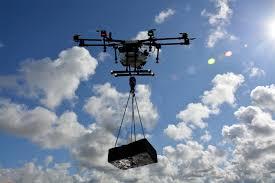Heavy-lift Cargo Drone Market Pain Points Hindering Widespread Industry Adoption
The heavy-lift cargo drone market is seen as a game-changer in modern logistics, offering the promise of faster, more efficient, and environmentally friendly cargo transport. Designed to carry substantial payloads over long distances, these drones could revolutionize how goods are delivered in sectors like logistics, agriculture, construction, and disaster relief. However, despite significant technological advances and growing interest, the market is experiencing a range of pain points that continue to hinder its broader adoption. Understanding and addressing these challenges is essential to unlocking the full potential of heavy-lift cargo drones.

Limited Battery Life and Payload Constraints
One of the foremost technical limitations is the insufficient energy density of current battery technologies. Heavy-lift drones require high power output to sustain flight while carrying large payloads, yet battery capacity remains a major bottleneck. As payload weight increases, flight time and range decrease sharply, limiting the feasibility of long-distance or extended operations.
Alternative propulsion technologies like hybrid engines or hydrogen fuel cells are in development, but they are not yet scalable or cost-effective for widespread use. Until energy storage improves significantly, performance limitations will remain a critical challenge.
High Capital and Operational Costs
The development and deployment of heavy-lift drones involve considerable capital investment. These drones require robust materials, precision engineering, advanced navigation systems, and high-capacity energy sources—all of which drive up manufacturing costs. Moreover, operators must invest in ground support infrastructure, training, licensing, and maintenance.
Operational expenses are also substantial. These include insurance premiums, software licensing, storage facilities, and regulatory compliance costs. For small and mid-sized enterprises, these financial burdens often outweigh the perceived benefits, slowing down market penetration.
Regulatory Uncertainty and Compliance Barriers
The absence of consistent and comprehensive regulatory frameworks is another pain point affecting the heavy-lift cargo drone market. Different countries have varying rules regarding drone operation, particularly for long-range or Beyond Visual Line of Sight (BVLOS) flights. These inconsistencies create legal and operational ambiguity for companies looking to scale across borders.
Furthermore, obtaining certification for heavy-lift drones can be a lengthy and complex process, especially in regions where aviation authorities are still developing unmanned aircraft systems (UAS) regulations. This regulatory fragmentation delays innovation, limits international expansion, and discourages investment in new drone technologies.
Lack of Infrastructure and Logistics Integration
Heavy-lift drones require specialized infrastructure to operate effectively. This includes launch and landing pads, charging or refueling stations, maintenance hubs, and control centers. In most regions, such infrastructure is either nonexistent or underdeveloped. This lack of readiness hampers deployment, particularly in rural or underserved areas where drone logistics could otherwise offer the most benefits.
In addition, integrating drone operations into existing logistics networks and IT systems remains a complex undertaking. Many logistics providers still lack the software tools, APIs, and workflow frameworks needed to efficiently manage drone fleets alongside traditional vehicles.
Weather Dependency and Environmental Limitations
Weather conditions significantly impact the reliability and safety of drone operations. High winds, heavy rain, fog, and temperature extremes can affect flight stability, sensor performance, and battery efficiency. For heavy-lift drones, these factors are even more critical, as a sudden shift in conditions can jeopardize both the payload and the drone itself.
This dependency on favorable weather limits the use of drones in certain geographic regions or seasons and undermines their potential for emergency and disaster response where conditions are unpredictable.
Cybersecurity and Data Privacy Concerns
As drone technology becomes increasingly autonomous and connected, cybersecurity risks are rising. Heavy-lift cargo drones rely on GPS navigation, wireless communication, and cloud-based command systems—all of which are vulnerable to cyberattacks. A compromised drone could lead to stolen cargo, surveillance breaches, or even physical harm in the event of system failure or hijacking.
Data privacy is also a growing concern, especially for industries handling sensitive or proprietary materials. Without robust cybersecurity protocols and encryption standards, companies may hesitate to entrust valuable goods to drone-based delivery systems.
Public Perception and Safety Concerns
Another major pain point is the public perception of safety and noise pollution. Many people remain skeptical of large drones flying over populated areas, fearing potential crashes, interference with commercial aircraft, or disruption to daily life. Heavy-lift drones, by their nature, are larger, noisier, and potentially more hazardous than smaller consumer drones.
Gaining public trust and social acceptance is essential for widespread adoption. Until comprehensive safety standards, clear communication, and community engagement are prioritized, public resistance may continue to slow growth.
Skill Gaps and Workforce Readiness
Operating heavy-lift drones requires specialized knowledge in aviation, robotics, maintenance, and data analytics. However, the labor market currently lacks sufficient professionals with these skill sets. Training and certifying drone pilots and maintenance personnel is both time-consuming and costly.
For businesses, this means longer ramp-up times, higher training costs, and increased dependency on a small talent pool, which could restrict scalability and limit operational efficiency.
Conclusion: Overcoming the Barriers to Unlock Full Market Potential
The heavy-lift cargo drone market holds tremendous promise, but its progress is being held back by a range of persistent pain points. From technological limitations and regulatory hurdles to public perception and infrastructure gaps, these challenges must be addressed collaboratively by industry players, governments, and technology developers.
Strategic investments in R&D, regulatory reform, infrastructure development, and workforce training are essential to overcoming these barriers. If these pain points are resolved, heavy-lift cargo drones have the potential to transform global logistics, enabling faster, greener, and more flexible cargo delivery systems for the future.
- Art
- Causes
- Crafts
- Dance
- Drinks
- Film
- Fitness
- Food
- Games
- Gardening
- Health
- Home
- Literature
- Music
- Networking
- Other
- Party
- Religion
- Shopping
- Sports
- Theater
- Wellness


